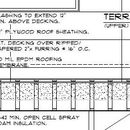Roof EPDM insulation with open cell
Been pondering a lot about this, I built a home about 2 years ago where the architect specified R-42 open cell in the roof underside and EPDM on the exterior (flat Roof). I actually ended up putting 20″ of open Cell on the underside for R-70.
My roofer laid down 1/2″ polyiso (standard practice) then EPDM on top.
My question here is given the vapor retardation properties of the EPDM and only 1/2″ of insulation outside–is there cause for concern? The Total r value is around R-73. Climate Zone 5-Upstate NY
I assume this means any potential vapor would flow into the house and as long as the ERV’s are operational then the system is alright but let me know if there are any gotchas?
GBA Detail Library
A collection of one thousand construction details organized by climate and house part










Replies
What is your climate zone or ZIP code?
Climate zone 5 :-)
I think you want to avoid moisture accumulating in the foam (especially during the winter with the stack effect). Whatever drying you have will occur to the inside, which mean controlling interior humidity levels using a dehumidifier might be necessary. I'm assuming you have drywall covering the ceiling. Do you have any recessed lights? If so, that would put your assembly at greater risk.
There may be other issues with this assembly. Let's see what the experts think.
Although it is a code-compliant assembly, because open cell foam is an air barrier (in sufficient thickness), in climate zone 5 it is risky and could lead to moisture accumulation at the sheathing. The risk is reduced if you have good humidity control, a variable permeance membrane at the interior, an airtight interior (membrane or drywall), and/or if the roof is in full sun on sunny days. If you don't have any of those things, I would be concerned.
It's all drywall interior-- Relative humidity has been naturally low inside during winter and ERV maintains humidity levels very well through-out the year.
Do you know how to read a psychrometric chart? That will give an indication of the risk of moisture accumulation. With R-70 total and only 1/2" foam on the exterior, the condensing surface--the underside of the roof sheathing--will condense water if the outside air temperature is below the dewpoint temperature for some length of time. (Dewpoint temperature is a redundant phrase but I think it's more clear than just saying dewpoint.) What that length of time that is depends on many factors; a full hygrothermal analysis (WUFI or similar) would have to be done to get a better idea, and even those are never perfect. Suffice to say, your assembly is risky, and potentially very risky. I would consider getting a moisture sensor with long probes so you can check what's going on near the sheathing. Late winter and spring is when problems usually show up.
Deleted